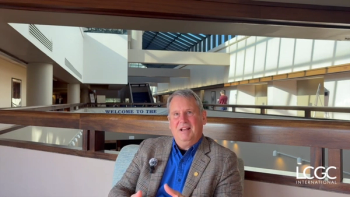
LC-MS in Evironmental, High-Throughput, and Other Applications
Eight presentations on a variety of LC-MS applications were given in Session 170 on this first afternoon at Pittcon. One of the most interesting was session 170-6, "Techniques of LC-MS in Forensics Analysis." The speaker, Michael C. Zumwalt, discussed the variety of LC-MS instrumentation available to meet both qualitative and quantitative needs. Among the interesting applications he discussed were those for detecting drugs of abuse and explosives. Workplace drug testing and forensic toxicology are examples of these applications. LC-MS continues to be a rapidly growing technique, and the ways in which it can be used in forensic analysis are quite varied. Serial measurement systems are used for quantitation, while parallel systems are best for qualitative applications. Serial systems such as single quadrupole and triple quadrupole mass spectrometers are very useful for detecting drugs of abuse in oral fluids. A particular advantage noted by the speaker is the ease of sample collection, which can even be done in the field, for example, by a police officer.
Eight presentations on a variety of LC-MS applications were given in Session 170 on this first afternoon at Pittcon. One of the most interesting was session 170-6, “Techniques of LC-MS in Forensics Analysis.” The speaker, Michael C. Zumwalt, discussed the variety of LC-MS instrumentation available to meet both qualitative and quantitative needs. Among the interesting applications he discussed were those for detecting drugs of abuse and explosives. Workplace drug testing and forensic toxicology are examples of these applications. LC-MS continues to be a rapidly growing technique, and the ways in which it can be used in forensic analysis are quite varied. Serial measurement systems are used for quantitation, while parallel systems are best for qualitative applications. Serial systems such as single quadrupole and triple quadrupole mass spectrometers are very useful for detecting drugs of abuse in oral fluids. A particular advantage noted by the speaker is the ease of sample collection, which can even be done in the field, for example, by a police officer.
Parallel systems such as time-of-flight (TOF), ion trap (IT), and quadrupole time-of-flight (QTOF) mass spectrometers are useful for determining the chemical formula of the substance that is present. The IT mass spectrometer is helpful when screening for the presence of drugs in urine. TOF mass spectrometry can be used effectively to detect explosives in soil samples. And QTOF is often used to monitor doping by athletes.
The final presentation in this session, 170-8, “Isolation and Separation of Phospholipids from Soybean By-Product,” discussed the use of supercritical fluid chromatography (SFC) coupled with evaporative light scattering detection (ELSD) and mass spectrometry (MS) to study phospholipids. Older methods such as thin layer chromatography and high performance liquid chromatography coupled with ultraviolet, refractive index, flame ionization detector, and mass spectrometry (MS) detection have been viewed somewhat negatively for the study of phospholipids because they were time-consuming and lacked quantitative accuracy. Much faster results were obtained with the SFC technique.
Newsletter
Join the global community of analytical scientists who trust LCGC for insights on the latest techniques, trends, and expert solutions in chromatography.





